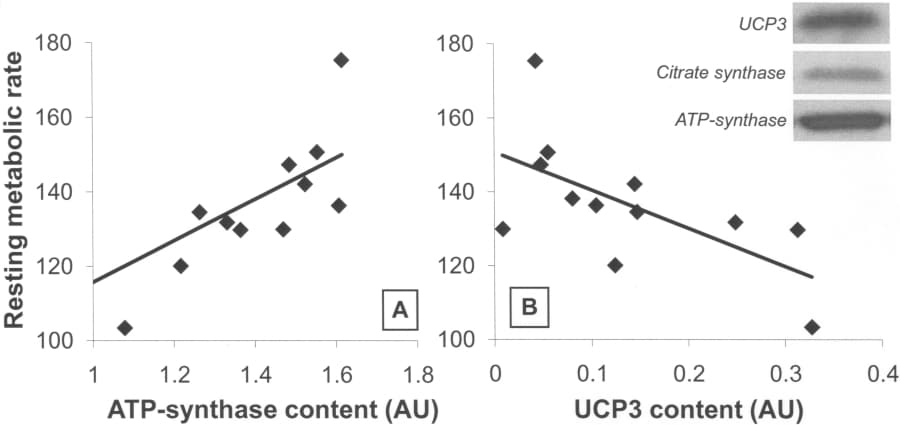Uncoupling protein 3 (UCP3) is a mitochondrial protein found principally in skeletal and cardiac muscle, and thought to play a role in reducing reactive oxygen species (ROS) production via respiratory uncoupling. We therefore examined the relationships between UCP3, resting metabolism and oxidative modification of myocellular proteins in fit, young men. METHODS: Twelve male subjects were recruited from the Oxford colleges’ rowing crews. Resting metabolic rate (RMR) was estimated from respired gases during a ten-minute period of quiet sitting. Percutaneous needle biopsies were taken from the m. vastus lateralis of each subject under local anaesthetic (5ml of 2% Lidocaine), and snap-frozen in liquid nitrogen. UCP3, citrate synthase and ATP-synthase protein content were measured by western blotting. Protein carbonylation was measured using the DNPH-derivitization method of Levine et al.1. All western blots were performed in duplicate. RESULTS: We observed an inverse correlation between UCP3 and mass2/3-adjusted RMR (r = -0.63, P < 0.05, n = 12, Fig. 1B). This relationship remained after UCP3 was normalised to either citrate synthase or ATP-synthase (r = -0.66 and r = -0.69, both P < 0.05, n = 12). Furthermore, there was a positive correlation between mass2/3-adjusted RMR and ATP-synthase content (r = 0.65, P < 0.05, n = 12, Fig. 1A). There was no significant relationship between UCP3 level and protein oxidation. DISCUSSION: Mitochondrial ROS-production is highly dependent upon the inner membrane potential, or protonmotive force. As UCP3 knock-out mice display increased skeletal muscle ROS-production, it has been suggested that UCP3 may act as an antioxidant by dissipating the protonmotive force under certain conditions. We observed an inverse relationship between UCP3 and RMR, the opposite of what would be expected if UCP3 were a significant uncoupler of oxidative phosphorylation. However, UCP3 is lower in trained than untrained individuals, and RMR may be higher in trained individuals. The observed relationship may therefore be secondary to a range of physical fitness in our cohort. We did not observe a relationship between UCP3 and myocellular protein oxidation. Taken together, our data show that fit, young men with a high metabolic rate have a higher content of the ATP-synthase, but a correspondingly lower content of UCP3, with perhaps all being due to a higher level of physical fitness.
University of Cambridge (2008) Proc Physiol Soc 11, C49
Oral Communications: Uncoupling protein 3 inversely correlates with resting metabolic rate in fit, young men
L. M. Edwards1,2, N. S. Knight1, C. J. Holloway1,2, D. Woods1, S. Tyler1, A. J. Murray3, P. A. Robbins1, K. Clarke1
1. Department of Physiology, Anatomy and Genetics, University of Oxford, Oxford, United Kingdom. 2. Oxford Centre for Clinical Magnetic Resonance Research, John Radcliffe Hospital, Oxford, United Kingdom. 3. Department of Physiology, Development and Neuroscience, University of Cambridge, Cambridge, United Kingdom.
View other abstracts by:
The relationships between mass-adjusted resting metabolic rate (in kcal day-1 kg-2/3) and (A) ATP-synthase and (B) UCP3 content in whole muscle homogenates (n = 12). AU = arbitrary units.
Where applicable, experiments conform with Society ethical requirements.

